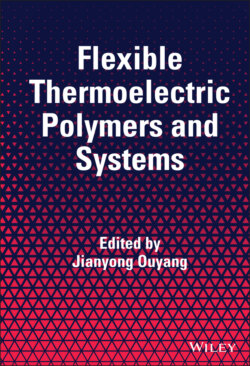Flexible Thermoelectric Polymers and Systems

Реклама. ООО «ЛитРес», ИНН: 7719571260.
Оглавление
Группа авторов. Flexible Thermoelectric Polymers and Systems
Table of Contents
List of Tables
List of Illustrations
Guide
Pages
Flexible Thermoelectric Polymers and Systems
List of Contributors
Preface
1 Fundamental Knowledge on Thermoelectric Materials
1.1 Properties of Thermoelectric Materials
1.1.1 Thermoelectric Effect
1.1.2 Seebeck Effect
1.1.3 Peltier Effect
1.1.4 Thomson Effect
1.1.5 Electrical Conductivity
1.1.5.1 Charge Carrier Density
1.1.5.2 Charge Carrier Mobility
1.1.5.3 Temperature Dependence of Conductivity
1.1.5.3.1 Metals
1.1.5.3.2 Semiconductors
1.1.5.3.3 Conducting Polymers
1.1.5.4 Conductivity of Composites
1.1.6 Thermal Conductivity
1.2 Thermoelectric Generators. 1.2.1 Dependence of Thermoelectric Efficiency on ZT
1.2.2 Effect of Electrical and Thermal Contact Resistances On Thermoelectric Performance
1.2.3 Equation of Thermoelectric Efficiency
1.3 Peltier Cooling
1.4 Thermoelectric Sensors
1.5 Summary
Acknowledgment
References
2 Conductive Polymers for Flexible Thermoelectric Systems
2.1 Introduction
2.1.1 The Discovery and Development of Conductive Polymers
2.1.2 Representative Structures
2.1.2.1 Polyacetylene (PAc)
2.1.2.2 Polyaniline (PAni)
2.1.2.3 Polypyrrole (PPy)
2.1.2.4 Polythiophene (PTh) and Derivatives
2.1.3 Conductive Mechanism
2.2 Chemical Design and Synthesis of Conductive Polymers
2.2.1 Energy Level Design of Conjugated Polymers
2.2.2 Tuning Molecular Conformations
2.2.3 Melt and Solution Processability
2.3 Doping of Conductive Polymers
2.3.1 n‐Type Doping
2.3.2 p‐Type Doping
2.4 The Properties of Poly(3,4‐ethylenedioxythiophene) 2.4.1 Oxidative and in situ Polymerization of EDOT to PEDOT
2.4.2 Counterions for PEDOT
2.4.3 PEDOT:PSS
2.4.4 Applications in Organic Electronics. 2.4.4.1 As an Electrode in Organic Solar Cells
2.4.4.2 Buffer Layer in Organic Solar Cells
2.4.4.3 Polymer‐Based Organic Thermoelectric Generators
2.5 Processing Technics for Flexible Thermoelectric Generators
2.6 Conclusions and Perspectives
Acknowledgments
References
3 Flexible Thermoelectrics Based on Poly(3,4‐Ethylenedioxythiophene)
3.1 Introduction
3.2 TE Materials and Devices. 3.2.1 Fundamental Principles and Theory of Thermoelectrics
3.2.2 PEDOT and Its Composites as TE Materials
3.2.3 General Configuration of TE Devices and Generators
3.2.4 Parameters of TE Device and Generator Performances
3.2.4.1 Output Voltage
3.2.4.2 Output Power Density
3.3 PEDOT‐Based Flexible TE Materials
3.4 PEDOT:PSS‐Based TEGs
3.5 Conclusions and Perspectives
Acknowledgments
Conflict of Interests
References
4 Flexible Thermoelectric Plastic Via Electrochemistry
4.1 Introduction
4.2 Electrochemical Deposition of CPs
4.3 Electronic Structure and Optical Properties
4.4 Electrochemical Doping and De‐doping
4.5 Thermoelectric Performance of Flexible CP Films. 4.5.1 Polythiophenes
4.5.2 Polyselenophenes
4.5.3 Polycarbazolyls
4.5.4 Copolymers
4.6 Control in Thermoelectric Performance by Electrochemistry
4.7 Conclusions
Acknowledgments
References
5 Thermoelectric Properties of Conducting Polymers with Ionic Conductors
5.1 Introduction
5.2 Mixed Ionic‐Electronic Conductors
5.3 Ionic Conductor/Conducting Polymer Heterostructures
5.4 High‐Performance Ion‐Conducting TE Polymers
5.5 Applications of Electronic–Ionic Coupled TE Organics
5.5.1 TE Generators
5.5.2 Ionic TE Capacitors
5.5.3 Multifunctional Sensors
5.6 Summary
Acknowledgments
References
6 Thermoelectric Properties of Carbon Nanomaterials/Polymer Composites
6.1 Introduction
6.2 Conducting Polymers
6.2.1 PEDOT:PSS
6.2.1.1 CNT/PEDOT:PSS
6.2.1.2 Graphene/PEDOT:PSS
6.2.2 Polyaniline (PANI)
6.2.2.1 Powder Mixing Method
6.2.2.2 Solution Mixing Method
6.2.2.3 In Situ Polymerization Method
6.2.2.4 Layer‐by‐Layer (LBL) Deposition
6.2.3 Polypyrrole (PPy)
6.2.4 Other P‐Type Conducting Polymers
6.2.5 N‐Type TE Composites
6.3 Non‐Conducting Polymers
6.3.1 Wrap
6.3.2 Layer‐by‐Layer Deposition
6.3.3 Segregated Network
6.4 Ternary Thermoelectric Material
6.4.1 Non‐conducting Polymer
6.4.2 Conducting Polymer
6.5 Summary and Outlook
References
7 Low‐dimensional Thermoelectric Materials
7.1 Introduction
7.2 Zero‐Dimensional (0D) Inorganic Semiconducting Nanocrystals
7.2.1 Measurements
7.2.2 Materials and Properties. 7.2.2.1 Fullerene
7.2.2.2 Graphene Quantum Dots
7.3 One‐Dimensional (1D) Thermoelectric Materials
7.3.1 1D Organic Thermoelectric Materials
7.3.1.1 Poly(3,4‐Ethylenedioxythiophene) Nanowires
7.3.1.2 Other Polymer Nanowires
7.3.2 Carbon Nanotubes
7.4 Two‐Dimensional (2D) Thermoelectric Materials
7.4.1 Graphene
7.4.2 Black Phosphorus
7.4.3 Mxenes
References
Index. a
b
c
d
e
f
g
h
i
l
m
n
o
p
q
r
s
t
u
v
w
z
WILEY END USER LICENSE AGREEMENT
Отрывок из книги
Edited by
.....
Baoyang Lu Flexible Electronics Innovation Institute Jiangxi Science and Technology Normal University Nanchang P. R. China
Chunhong Lu Key Laboratory of Textile Science & Technology of Ministry of Education College of Textiles Donghua University Shanghai China
.....